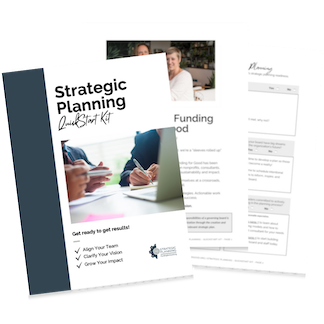One of the first questions many strategic planning clients have is: What is the timeline for a strategic planning process?
In practice, leaders are generally asking about two things:
- How long will the strategic planning process take?
- How long of a period should a strategic plan cover?
Let’s tackle these questions one at a time.
How Long Does a Strategic Planning Process Last?
In general, a strategic planning process should take 3-4 months, though some planning processes can take as long as a year. The length of time often depends on the complexity of the organization. A shorter timeline, however, has many benefits. It can enable leaders to focus deeply on strategy with the end goal always in sight. It can keep stakeholder engagement high. And it can help minimize dreaded “planning fatigue.”
Different consultants also use different strategic planning models and processes, which can affect the timeline. This is why it’s so important to find the right strategic planning consultant for your organization.
Are you ready to start the strategic planning process?
What is a Strategic Planning Timeline?
A strategic planning timeline is the period covered by an organization’s strategic plan. A strategic plan generally covers 3-5 years and includes the goals, strategies, and desired outcomes that an organization will achieve by the end of the timeframe. Some larger and more complex organizations may create plans for longer timelines, such as a 10-year strategic plan. While other organizations, especially those undergoing rapid shifts, may create shorter one-year plans.
Why Strategic Plans Often Cover a Timeline of 3-5 Years
For many organizations, a 3-5-year strategic plan timeline balances ambition and vision with the ability to remain agile.
With a 3-5-year timeline, an organization can envision—and achieve—ambitious goals. Yet 3-5 years is still a short enough period that an organization can pivot if conditions change dramatically. Whereas a longer timeline, such as 10 years, could leave leaders with many years of a strategic plan that no longer makes sense. But there are exceptions.
For some larger institutions, such as major universities, school districts, or government agencies, a 10-year strategic plan is more suitable. Institutions that are complex and well-established may focus on more iterative improvements—and a 10-year timeline can provide the slow, steady and strategic growth they need.
Strategic Plans Aren’t Meant to Be Static
While strategic plans give organizations a clear vision and direction over a longer-term time horizon, they aren’t meant to be static and unchanging.
Organizations don’t implement strategic plans in a vacuum. A range of factors can affect plans during implementation—from unexpected turnover in key staff roles to changes in community needs to broader economic instability. As Entrepreneur Magazine explains:
…because we live in a world that is changing faster and faster, we must adapt our plans in an agile way and harness the power of technology and systems to help us.
Remaining nimble yet grounded by a solid strategic plan, enables leaders to both navigate challenges and seize opportunities. That’s why Funding for Good encourages our clients to think of strategic plans as living documents.
Where Do You See Yourself in Five Years?
When thinking in terms of strategic planning timelines, the classic interview question takes on new meaning: “Where do you see yourself in five years?”
As leaders, having a 3-year or 5-year strategic plan for our organization keeps us focused on the future. And coupling this long-range strategy with clear annual plans enables us to fine-tune our implementation along the way. With these tools, we can learn and adapt without losing sight of our goals.


